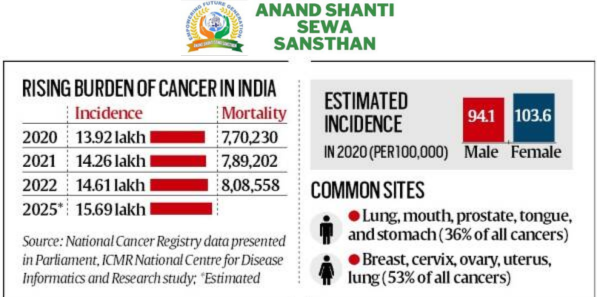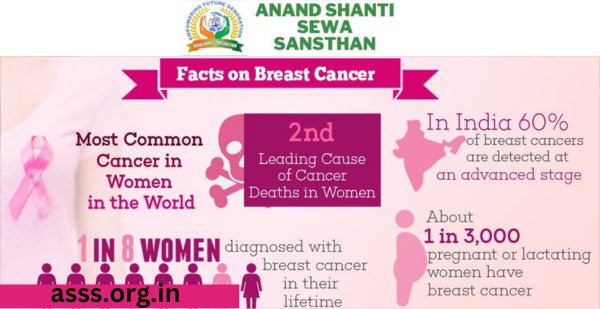Introduction:
Breast cancer is a significant public health concern globally, and its impact is particularly pronounced in India. With its diverse population, socio-economic disparities, and healthcare infrastructure challenges, India faces unique obstacles in battling breast cancer. Understanding the situation, root causes, effects, available treatments, and preventive measures is crucial for effective NGO interventions aimed at reducing the burden of breast cancer among Indian women.

The Situation of Breast Cancer in India:
Breast cancer has emerged as the most common cancer among Indian women, surpassing cervical cancer. The incidence of breast cancer is rising steadily, with approximately 1.5 lakh new cases reported annually. Furthermore, breast cancer tends to affect Indian women at a younger age compared to their Western counterparts, often striking in their 30s and 40s. This early onset poses additional challenges for diagnosis and treatment.
Factors contributing to the high prevalence of breast cancer in India include lifestyle changes, delayed childbirth, hormonal factors, genetic predisposition, and lack of awareness about screening and early detection. Additionally, limited access to quality healthcare services and cultural taboos surrounding discussions about breast health contribute to late-stage diagnoses and poor outcomes.

Root Causes and Risk Factors:
Several factors contribute to the development of breast cancer in Indian women:
a. Genetic Predisposition: A family history of breast cancer significantly increases the risk, particularly if first-degree relatives have been diagnosed with the disease.
b. Lifestyle Factors: Sedentary lifestyles, unhealthy dietary habits, obesity, and alcohol consumption have been linked to an increased risk of breast cancer.
c. Hormonal Influences: Early menarche, late menopause, and nulliparity (not having children) are associated with a higher risk of breast cancer due to prolonged exposure to estrogen.
d. Environmental Factors: Exposure to environmental pollutants, including pesticides and industrial chemicals, may increase the risk of breast cancer.
e. Lack of Awareness and Screening: Limited awareness about breast cancer symptoms, screening guidelines, and the importance of early detection leads to delayed diagnosis and poorer outcomes.

Effects of Breast Cancer:
Breast cancer not only affects the physical health of women but also has profound emotional, psychological, and socioeconomic consequences. The diagnosis of breast cancer can evoke fear, anxiety, and depression in patients, impacting their overall quality of life. Moreover, the financial burden of treatment, including surgery, chemotherapy, and radiation therapy, can push families into poverty and hinder access to follow-up care.
Beyond the individual level, breast cancer exerts a significant economic toll on society due to productivity losses, healthcare expenditures, and the strain on healthcare infrastructure. Furthermore, the loss of a woman’s contribution to her family and community due to premature death or disability further exacerbates the societal impact of breast cancer.

Available Treatments:
Treatment options for breast cancer in India vary depending on the stage of the disease and individual patient factors. Common treatment modalities include:
a. Surgery: Surgical interventions, such as lumpectomy (removal of the tumor) or mastectomy (removal of the breast), are often the primary treatment for localized breast cancer.
b. Chemotherapy: Chemotherapy may be recommended to shrink tumors before surgery (neoadjuvant chemotherapy) or to eliminate cancer cells after surgery (adjuvant chemotherapy).
c. Radiation Therapy: Radiation therapy is used to destroy cancer cells and reduce the risk of recurrence following surgery.
d. Hormonal Therapy: Hormonal therapy, including drugs that block estrogen receptors or reduce estrogen production, is prescribed for hormone receptor-positive breast cancers.
e. Targeted Therapy: Targeted drugs, such as Herceptin, are used to treat HER2-positive breast cancers by targeting specific proteins involved in cancer growth.
f. Immunotherapy: Immunotherapy drugs help the body’s immune system recognize and destroy cancer cells and are being studied as a treatment option for certain types of breast cancer.

NGO Initiatives for Breast Cancer Prevention:
NGOs play a crucial role in raising awareness, promoting early detection, providing support services, and advocating for policy changes to address breast cancer in India. Some key initiatives include:
a. Awareness Campaigns: NGOs conduct community outreach programs, workshops, and educational sessions to raise awareness about breast cancer risk factors, symptoms, and screening guidelines.
b. Screening Programs: NGOs collaborate with healthcare providers to offer breast cancer screening camps and mammography services in underserved communities, particularly rural areas where access to healthcare is limited.
c. Support Services: NGOs provide psychosocial support, counseling, and financial assistance to breast cancer patients and their families to help alleviate the emotional and financial burdens associated with the disease.
d. Survivorship Programs: NGOs organize support groups, survivorship workshops, and rehabilitation services to help breast cancer survivors cope with the physical and emotional challenges of life after treatment.
e. Advocacy and Policy Change: NGOs advocate for policies that improve access to affordable cancer care, strengthen healthcare infrastructure, and prioritize breast cancer screening and treatment services in national healthcare agendas.
Conclusion:
Breast cancer remains a significant public health challenge in India, necessitating comprehensive efforts from NGOs, government agencies, healthcare providers, and civil society to address its root causes, improve early detection, and enhance treatment outcomes. By raising awareness, promoting preventive measures, and providing support services, NGOs can play a pivotal role in reducing the burden of breast cancer and improving the quality of life for affected women across India. Together, we can work towards a future where every woman has access to timely diagnosis, effective treatment, and compassionate care, ultimately reducing the impact of breast cancer on individuals, families, and communities nationwide.


Very Good initiative by ASSS
We need these things to be seen also by govt.